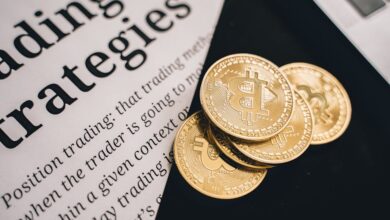Gold’s Enduring Value: A Comprehensive Guide to Investing in a Safe-Haven Asset Amid Economic Uncertainty

In an era marked by economic volatility and uncertainty, investors are increasingly turning to traditional safe-haven assets to safeguard their wealth. Among these, gold has long been revered for its enduring value and stability. This article delves into the multifaceted reasons why gold continues to shine as a reliable refuge during turbulent times. We will explore the intricate relationship between gold prices and inflation, offering insights into how this precious metal can serve as a hedge against rising costs. Additionally, we will examine various investment strategies, from exchange-traded funds (ETFs) to physical gold and mining stocks, to help investors navigate the complexities of the gold market.
Central bank policies play a significant role in shaping gold prices, and we will analyze how these strategies influence investor confidence. In an age where cryptocurrencies are gaining traction, we will compare gold with digital currencies to determine which better protects against inflation. Historical trends will also provide valuable context, shedding light on gold's performance and its implications for future investment. Finally, we will discuss how geopolitical tensions impact gold demand and prices, further solidifying its status as a cornerstone of diversified investment portfolios. Join us as we uncover the enduring allure of gold in our quest for financial security amidst uncertainty.
- 1. "Gold as a Safe-Haven Asset: Navigating Economic Uncertainty"
- 2. "Inflation and Gold: Understanding the Price Dynamics"
- 3. "Investing in Gold: Strategies from ETFs to Physical Assets"
1. "Gold as a Safe-Haven Asset: Navigating Economic Uncertainty"
Throughout history, gold has consistently been viewed as a safe-haven asset, particularly during periods of economic uncertainty. Investors often turn to gold when traditional markets exhibit volatility, fearing inflation, currency devaluation, or geopolitical turmoil. This enduring appeal is largely due to gold's intrinsic value, scarcity, and the fact that it is universally recognized as a form of wealth.
During economic downturns or crises, confidence in fiat currencies can wane. In contrast, gold tends to retain its purchasing power, making it a desirable alternative for safeguarding wealth. For instance, during the 2008 financial crisis, gold prices surged as investors sought stability amid plummeting stock markets and rising fears of inflation. This trend has continued, with gold often experiencing price increases in response to economic indicators that signal instability.
Additionally, gold's performance during periods of inflation underscores its role as a hedge against rising prices. As the cost of living increases, the demand for gold typically rises, further driving up its price. This relationship is particularly relevant in today’s economic climate, where central banks have implemented expansive monetary policies that can lead to inflationary pressures.
Furthermore, gold's liquidity and ease of access make it an attractive option for investors looking to diversify their portfolios. Unlike other assets that may be more susceptible to market fluctuations, gold often provides a stabilizing effect, allowing investors to navigate economic uncertainty with greater confidence.
In summary, gold's historical resilience, intrinsic value, and ability to act as a hedge against inflation and currency devaluation solidify its status as a safe-haven asset. As economic uncertainties continue to arise, gold remains a cornerstone for investors seeking security and stability in turbulent times.
2. "Inflation and Gold: Understanding the Price Dynamics"
Inflation has a significant influence on the dynamics of gold prices, as the precious metal is often perceived as a hedge against rising inflation. When inflation increases, the purchasing power of fiat currencies declines, leading investors to seek assets that retain value. Gold, with its intrinsic value and historical role as a store of wealth, becomes an attractive option during such times.
As inflation rises, the real return on bonds and cash diminishes, prompting investors to pivot towards gold. This shift is fueled by the perception that gold can preserve wealth better than traditional currencies, which may lose value. Consequently, demand for gold typically increases, driving up its price. Historical data supports this correlation; for instance, during periods of high inflation, such as the 1970s in the United States, gold prices surged significantly.
Moreover, central bank policies also play a crucial role in the relationship between inflation and gold. When central banks implement loose monetary policies, such as lowering interest rates or engaging in quantitative easing, the supply of money in the economy increases. This can lead to higher inflation expectations, further enhancing gold’s appeal as a hedge. Investors often turn to gold not only for its potential appreciation but also as a safeguard against the erosion of purchasing power.
Understanding these price dynamics is essential for investors looking to navigate economic uncertainty. By monitoring inflation trends and central bank actions, investors can make more informed decisions regarding their gold investments, ensuring they are positioned to benefit from potential price movements in this safe-haven asset.
3. "Investing in Gold: Strategies from ETFs to Physical Assets"
Investing in gold can be approached through various strategies, each with its own advantages and considerations. Three of the most popular methods include exchange-traded funds (ETFs), physical gold, and mining stocks.
Exchange-Traded Funds (ETFs) provide a convenient way to invest in gold without the need to hold the physical asset. Gold ETFs typically track the price of gold bullion, allowing investors to gain exposure to gold's price movements. They are traded on major stock exchanges, making them easy to buy and sell. This method offers liquidity and lower transaction costs compared to purchasing physical gold. However, investors should be aware of management fees and the fact that they do not own the physical gold itself.
Investing in physical gold, such as coins or bars, offers a tangible asset that can serve as a hedge against economic instability. Physical gold is often viewed as a store of value in times of crisis, providing a sense of security. While it can be more costly to buy and sell due to premiums, insurance, and storage fees, owning physical gold eliminates counterparty risk associated with financial instruments. Investors should carefully consider where and how to store their physical gold to ensure its safety.
Mining stocks represent another way to invest in gold, offering exposure to the potential profitability of gold mining companies. These stocks can provide leveraged returns based on gold price movements, as companies may experience significant profit increases when gold prices rise. However, investing in mining stocks comes with added risks, including operational challenges and fluctuating production costs. Therefore, it’s essential for investors to research individual companies and understand the broader market dynamics.
Each of these investment strategies can play a role in a diversified portfolio. By considering personal financial goals, risk tolerance, and market conditions, investors can determine the best approach to incorporate gold into their investment strategy.
In conclusion, gold's enduring status as a safe-haven asset during periods of economic uncertainty is underpinned by its unique characteristics and historical performance. As we have explored, gold tends to appreciate in value during inflationary periods and can serve as a reliable hedge against rising prices. Investors have a variety of options for incorporating gold into their portfolios, whether through exchange-traded funds (ETFs), physical bullion, or mining stocks, each with its own risk and return profile.
Central bank policies significantly influence gold prices, as changes in interest rates and monetary supply can sway investor sentiment and demand. Additionally, geopolitical tensions often drive individuals and institutions toward gold, further solidifying its role as a protective asset in turbulent times. When compared to cryptocurrencies, gold continues to demonstrate its value as a stable hedge against inflation, showcasing its resilience in the face of emerging financial technologies.
Historically, gold has displayed upward trends during crises, providing important insights for future market behavior. By integrating gold into a diversified investment strategy, investors can enhance their financial resilience while navigating the complexities of today's economic landscape. Ultimately, as global uncertainties persist, gold remains a key asset for those seeking stability and protection in their investment endeavors.





